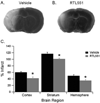Recombinant T cell receptor ligands improve outcome after experimental cerebral ischemia
- PMID: 21961027
- PMCID: PMC3181103
- DOI: 10.1007/s12975-011-0085-1
Recombinant T cell receptor ligands improve outcome after experimental cerebral ischemia
Abstract
A key target for novel stroke therapy is the regulation of post-ischemic inflammatory mechanisms. Recent evidence emphasizes the role of T lymphocytes of differing subtypes in the evolution is ischemic brain damage. We have recently demonstrated the benefit of myelin antigen-specific immunodulatory agents known as recombinant T cell receptor ligands (RTLs) in a standard murine model of focal stroke. The aim of the current study was to extend this initial observation to RTL treatment in a therapeutically relevant timing after middle cerebral artery occlusion (MCAO) and verify functional benefit to complement histological outcome measures. We observed that the administration of mouse-specific RTL551 reduced infarct size and improved sensorimotor outcome when administered within a 3 h post-ischemic therapeutic window. RTL551 treatment reduced cortical, caudate putamen, and total infarct volume as compared to vehicle-treated mice. Using a standard behavioral testing repertoire, we observed that RTL551 reduced sensorimotor impairment 3 days after MCAO. Humanized RTL1000 (HLA-DR2 moiety linked to hMOG-35-55 peptide) also reduced infarct size in HLA-DR2 transgenic mice. These data indicate that this neuroantigen-specific immunomodulatory agent reduces damage when administered in a therapeutically relevant reperfusion timeframe.
Figures



References
-
- Burrows GG, Chang JW, Bachinger HP, Bourdette DN, Offner H, Vandenbark AA. Design, engineering and production of functional single-chain T cell receptor ligands. Protein Eng. 1999;12:771–778. - PubMed
-
- Emsley HC, Smith CJ, Georgiou RF, Vail A, Tyrrell PJ, Barberan EM, et al. Correlation of systemic inflammatory response with infarct volume in acute ischemic stroke patients. Stroke. 2005;36:228–229. - PubMed
-
- Finn TP, Jones RE, Rich C, Dahan R, Link J, David CS, et al. HLA-DRB1*1501 risk association in multiple sclerosis may not be related to presentation of myelin epitopes. J Neurosci Res. 2004;78:100–114. - PubMed
-
- Gelderblom M, Leypoldt F, Steinbach K, Behrens D, Choe CU, Siler DA, et al. Temporal and spatial dynamics of cerebral immune cell accumulation in stroke. Stroke. 2009;40:1849–1857. - PubMed
Grants and funding
LinkOut - more resources
Full Text Sources
Other Literature Sources
Research Materials

